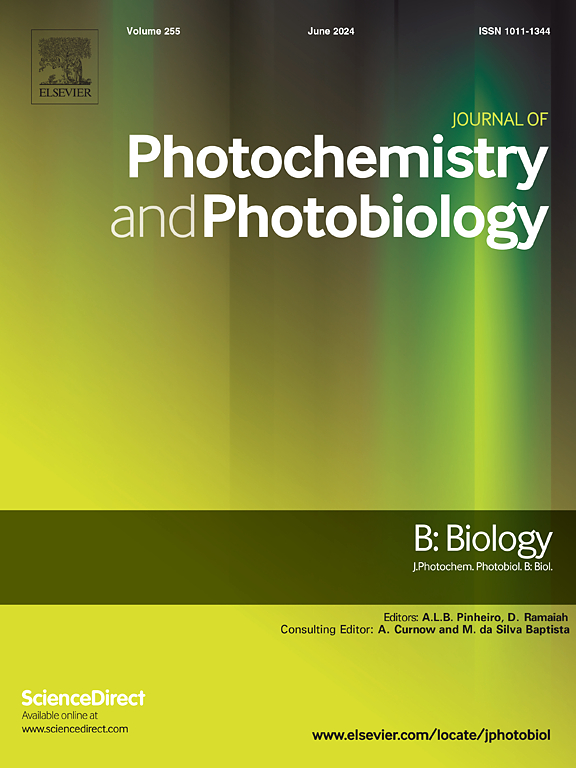Photodynamic antimicrobial therapy with Erythrosin B, Eosin Y, and Rose Bengal for the inhibition of fungal keratitis isolates: An in vitro study
IF 3.9
2区 生物学
Q2 BIOCHEMISTRY & MOLECULAR BIOLOGY
Journal of photochemistry and photobiology. B, Biology
Pub Date : 2025-02-01
DOI:10.1016/j.jphotobiol.2024.113090
引用次数: 0
Abstract
Introduction
Fungal keratitis is a leading cause of corneal blindness, with current antifungal treatments having limited efficacy. One promising treatment modality is Rose Bengal (RB) photodynamic antimicrobial therapy (PDAT) that has shown mixed success against fungal keratitis. Therefore, there is a need to explore the antimicrobial efficacy of other green-light activated photosensitizers that have deep penetration in the cornea to combat the deep fungal infections, such as Erythrosin B (EB) and Eosin Y (EY).
Objective
This study will explore PDAT inhibitory effects with different photosensitizers, RB, EB, and EY against two common fungal ocular isolates, Aspergillus spp. and Fusarium spp.
Methods
Twelve fungal isolates (Fusarium spp., n = 6, Aspergillus spp., n = 6) were prepared in suspension for evaluation of growth inhibition to PDAT with three photosensitizers, EB, EY, and RB. Custom green light source (λ = 518 nm, energy density = 5.4 J/cm2) was applied to the experimental groups for 15 min. Fungal growth inhibition was assessed after experimentation by analyzing the area of growth within the irradiated zone on agar plates.
Results
All twelve fungal isolates showed no inhibition to EB, EY, and RB without irradiation. Fusarium spp. were more susceptible to PDAT than Aspergillus spp. In all Fusarium solani strains, all photosensitizers with light showed full inhibition within the 47 mm diameter irradiation zone.
Conclusion
EB, EY, and RB PDAT demonstrated comparable antifungal inhibition against six Fusarium ocular isolates; these findings in conjunction with the deeper tissue penetration of EB and EY, are of interest to treat more advanced and deeper cases of fungal keratitis.
红血素B、伊红Y和孟加拉玫瑰的光动力抗菌治疗对真菌角膜炎分离物的抑制作用:一项体外研究。
真菌性角膜炎是角膜失明的主要原因,目前的抗真菌治疗效果有限。一种有希望的治疗方式是玫瑰孟加拉(RB)光动力抗菌疗法(PDAT),它在治疗真菌性角膜炎方面取得了不同程度的成功。因此,有必要探索其他绿光激活光敏剂对角膜深部真菌感染的抗菌效果,如红血素B (EB)和伊红Y (EY)。目的:研究不同光敏剂RB、EB和EY对两种常见的眼珠真菌Aspergillus spp.和Fusarium spp.的抑制作用。方法:制备12株真菌(镰刀菌,n = 6,曲霉,n = 6),用悬浮液评价3种光敏剂EB、EY和RB对PDAT生长的抑制作用。将定制的绿色光源(λ = 518 nm,能量密度= 5.4 J/cm2)作用于实验组15 min。实验结束后,通过分析辐照区琼脂板上的生长面积来评估真菌的生长抑制。结果:12株真菌对EB、EY和RB均无抑制作用。镰刀菌对PDAT的敏感性高于曲霉,在47 mm直径的辐照范围内,所有光敏剂均表现出完全的抑制作用。结论:EB、EY和RB PDAT对6株眼镰孢菌具有相当的抑制作用;这些发现与EB和EY更深的组织渗透相结合,对治疗更晚期和更深的真菌性角膜炎病例很有意义。
本文章由计算机程序翻译,如有差异,请以英文原文为准。
求助全文
约1分钟内获得全文
求助全文
来源期刊
CiteScore
12.10
自引率
1.90%
发文量
161
审稿时长
37 days
期刊介绍:
The Journal of Photochemistry and Photobiology B: Biology provides a forum for the publication of papers relating to the various aspects of photobiology, as well as a means for communication in this multidisciplinary field.
The scope includes:
- Bioluminescence
- Chronobiology
- DNA repair
- Environmental photobiology
- Nanotechnology in photobiology
- Photocarcinogenesis
- Photochemistry of biomolecules
- Photodynamic therapy
- Photomedicine
- Photomorphogenesis
- Photomovement
- Photoreception
- Photosensitization
- Photosynthesis
- Phototechnology
- Spectroscopy of biological systems
- UV and visible radiation effects and vision.

 求助内容:
求助内容: 应助结果提醒方式:
应助结果提醒方式:


